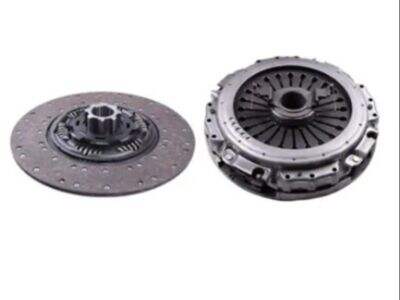Chomh maith leis sin agus tú ag tiomáint tarchur láimhe (gluaisteán díosail) ach is gá an clutch a úsáid chun fearas a athrú. Is dócha gurb é an ceann is tábhachtaí mar go n-úsáideann tú é chun cumhacht a dhícheangal ó d'inneall le rothaí do charr. Cuirfidh sé ar do chumas giaranna a athrú go réidh gan iarracht. Gné amháin den sórt sin a fheidhmíonn mar phláta brú sa mheicníocht oibre ná clutch. Is é an chuid seo a bhrúnn an clutch isteach nó a tharraingíonn amach é, nuair a bhrúlann tú do chos síos ar an gcos.
Sula mbainfimid ann, áfach, déanaimis súil ar an gcomhthionól laistigh den chuid mhór eile sin; pláta brú clutch. Is clúdach miotail láidir é an ceann eile ina gcoimeádtar na codanna go léir taobh istigh, rud a chiallaíonn nach féidir iad a chur isteach nó a bheith scaoilte. Tá earrach ag an pláta brú a chabhraíonn leis nuair a bhíonn sé ag bogadh. Tá an clúdach bolted le flywheel ag baint úsáide as boltaí speisialta nach bhfuil aon bhearnaí san ábhar a úsáidtear. Nuair a bhrúnn tú isteach an cos clutch, is é sin nuair a bhogann an pláta brú sin ar shiúl ó rud ar a dtugtar diosca clutch. An cineál seo duit chun an Clutch Diosca isteach i do roth eitilte ar an inneall. D'fhéadfadh go n-athródh pláta brú olc do charr go hearráideach, rud a thugann duine faoi deara agus tú ag tiomáint.

Roghnú Pláta Brú Clutch
Bhuel, tá roinnt rudaí nach mór duit a mheabhrú agus an pláta brú clutch ceart ag Yichun Mak á roghnú agat do do charr. Is féidir é a shannadh ach fiafraí díot, más ann dó: Cén stíl tiomána bhunúsach a bheidh ag do charr? I gcásanna áirithe, ultra-ard-fheidhmíocht Clúdach clutch níl pláta brú ag teastáil don ghnáthcharr paisinéirí faoi thiomáint comaitéireachta nach féidir a phiocadh suas ach ar maidin Dé Sathairn nó tiomáint deireadh seachtaine. Mar sin féin, má tá sé ar intinn agat an fheithicil a iompar nó a rásaíocht easbhóthair, caithfidh an pláta brú clutch seo a bheith i bhfad níos déine i gcomparáid le daoine atá in ann gníomhaíochtaí den sórt sin a láimhseáil.
Is é an chéad cheann eile méid do phláta brú clutch.
Caithfidh an pláta brú (agus an clúdach clutch) d'inneall Porsche Cineál 2 a bheith de mhéid agus de chruth ar leith, mar sin beidh sé oiriúnach go dlúth le roth eitilte do charr. Is féidir leis na páirteanna a ghlanadh freisin gan oibriú chomh maith gan dea-oiriúnach nó níos measa, damáiste a dhéanamh do do charr. Téigh i gcomhairle le lámhleabhar úinéara do charr nó bíodh meicneoir chun fáil amach duit cén méid. Tá a fhios acu cad ba mhaith leat.
Ar dtús, cad as a bhfuil an pláta brú clutch déanta. Socraíonn na hábhair a úsáidtear i dtógáil conas a rachaidh an carr i dtreo an bhóthair oscailte. Ach ansin, b’fhéidir nach mbeadh carr freastail go rásaíocht agus tiomáint feidhmíochta i gcónaí oiriúnach do do chapall oibre laethúil. Cuir oideachas ort féin, le do thoil; agus déan beagán taighde ar cad a n-oibreoidh is fearr duit i bhfianaise do rún tiomána.
Cineálacha Plátaí Brú Clutch
Tá gach cineál cumraíochtaí pláta brú clutch ann lena buntáistí agus na míbhuntáistí aonair. Na trí phríomh-orgánach, ceirmeach agus miotalach.
Seasamh misinéirí an trealaimh seo; labhraíonn a uileláithreacht ar a son féin, agus mura bhfuil a fhios agat cén fáth orgánach Kit Clutch Tá an oiread sin tóir ar phlátaí brú le déanaí... tá a fhios agat na cinn, croí-cruach idir snáithíní nádúrtha a thugann braistint éigin do do mhéar ar na pillíní luamháin. Sin é an fáth a mheallann na gluaisteáin go leor daoine agus go bhfuil siad oiriúnach go foirfe le haghaidh tiomána laethúil, tá siad iontaofa agus dea-mhúinte timpeall orthu.
Tugadh faoi deara, áfach, gur thairg plátaí brú clutch ceirmeacha an fheidhmíocht i bhfeidhmiú ardfheidhmíochta thar cinn eile ar nós orgánach. Déanta as meascán de chruach agus ceirmeach i bhfad níos láidre ná eilimintí traidisiúnta, neamh-thréscaoilteach chun teas i bhfad níos mó suas go pointe. Mar sin, is réiteach foirfe é seo dóibh siúd ar mian leo roinnt tiomána ardfheidhmíochta nó fiú rásaíocht a bheith acu mar go mbeadh na camshafts seo níos mó ná in ann ualaí breise a láimhseáil orthu.
Miotalach:
Is iad an grúpa plátaí brú clutch seo na cinn is athléimní agus is tromshaothair le fada. Tá siad seo i ndáiríre miotail-déanta agus durable do láimhseáil struis is airde. Is cinnte gurb iad sin an pláta brú clutch is troime agus is costasaí le fada fós, agus déantar gach ceann acu an ceann is fearr chun rabhadh a thabhairt don tiomáint.

 EN
EN
 AR
AR
 BG
BG
 HR
HR
 CS
CS
 DA
DA
 NL
NL
 FI
FI
 FR
FR
 DE
DE
 EL
EL
 HI
HI
 IT
IT
 JA
JA
 KO
KO
 NO
NO
 PL
PL
 PT
PT
 RO
RO
 RU
RU
 ES
ES
 SV
SV
 CA
CA
 TL
TL
 ID
ID
 LV
LV
 LT
LT
 SR
SR
 UK
UK
 VI
VI
 HU
HU
 TH
TH
 TR
TR
 FA
FA
 AF
AF
 MS
MS
 SW
SW
 GA
GA
 HY
HY
 KK
KK